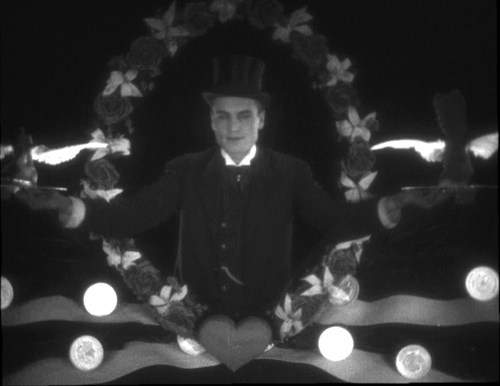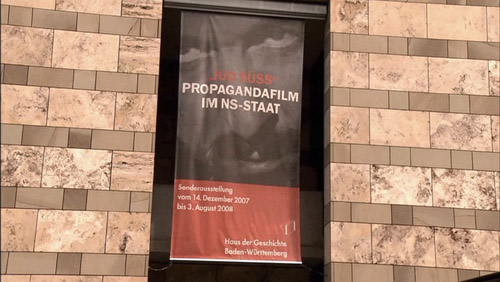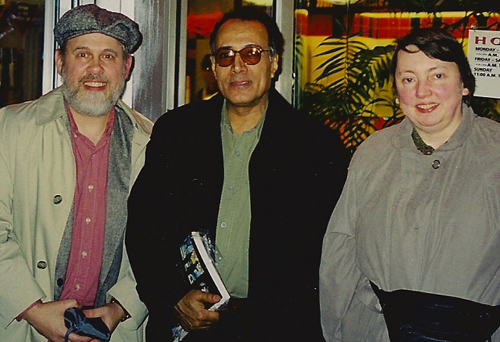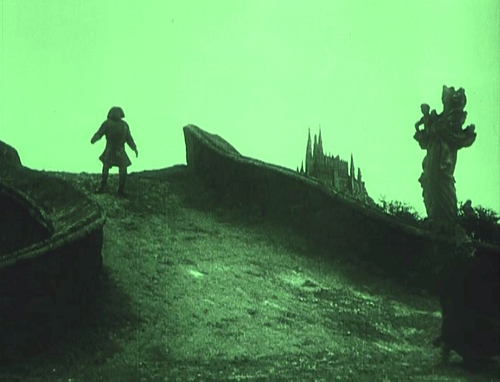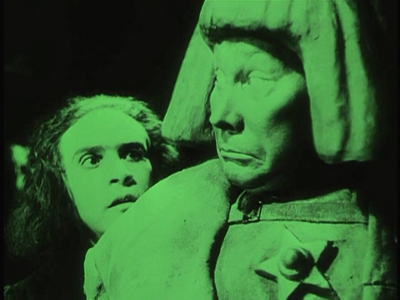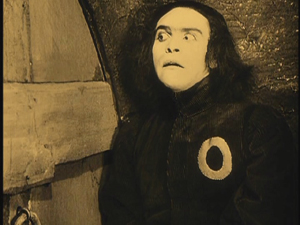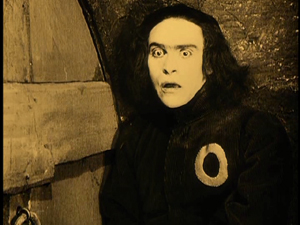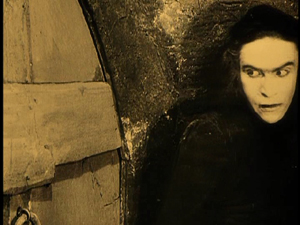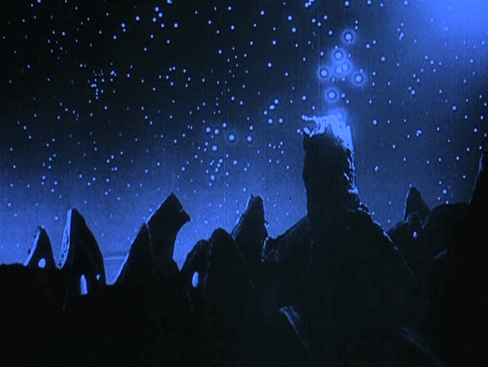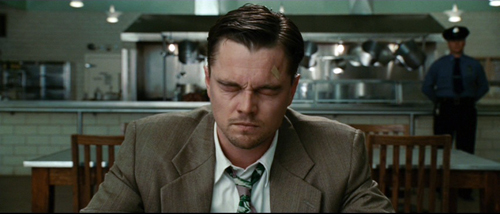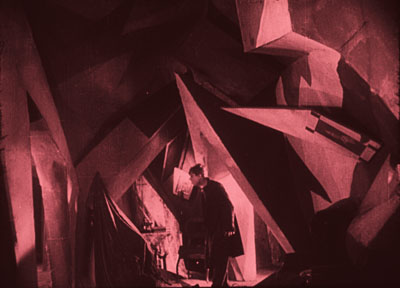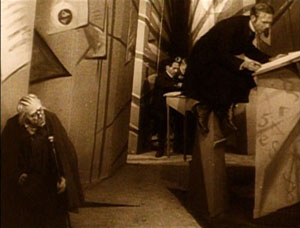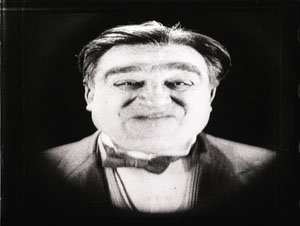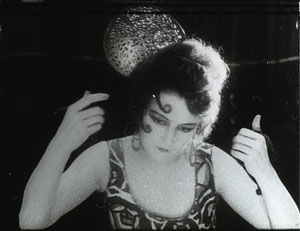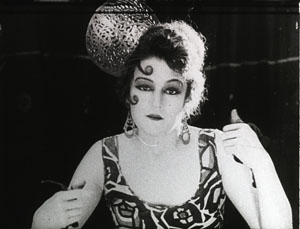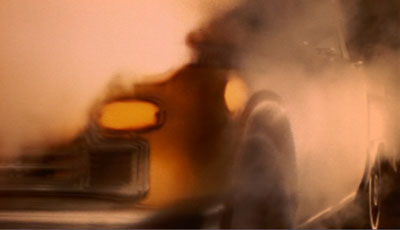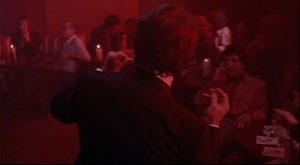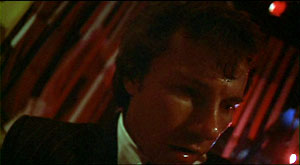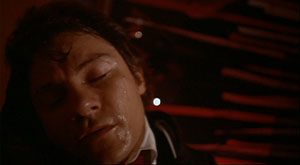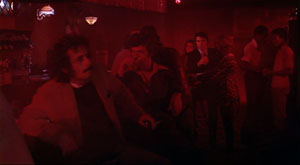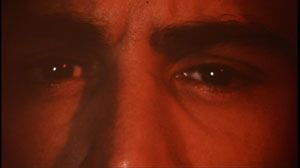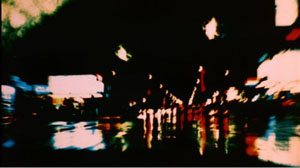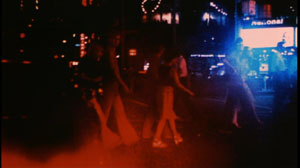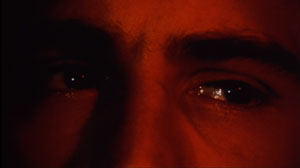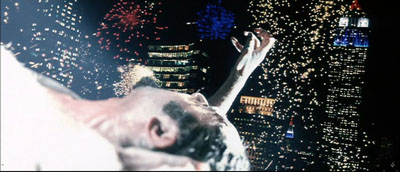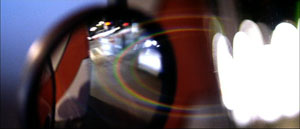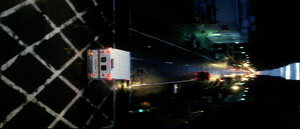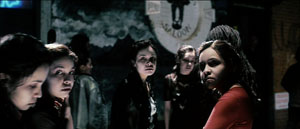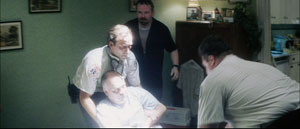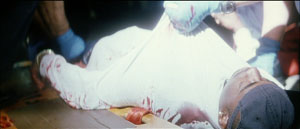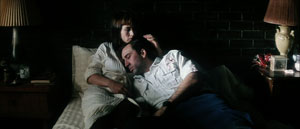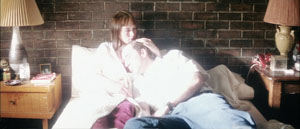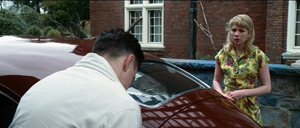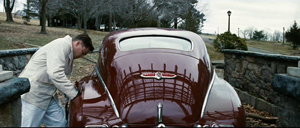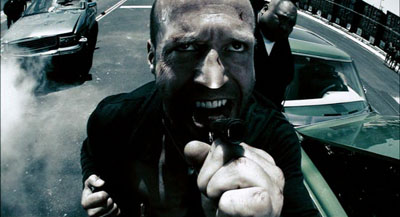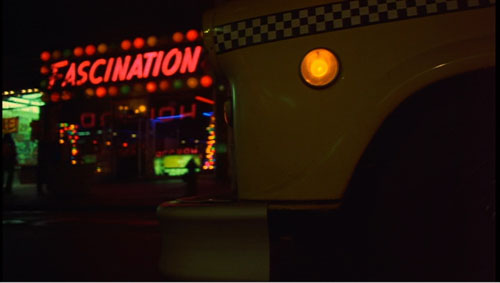Archive for the 'National cinemas: Germany' Category
More revelations of film history on DVD
The Great Consoler.
Kristin here:
Upon returning from Vancouver, we found the usual mountain of mail awaiting us. Among the bills and ads were some very welcome items: a new flock of DVDs of considerable historical interest.
A German Documentary on Veit Harlan
After Leni Reifenstahl, Veit Harlan is the most famous of the directors who made films for the Nazi regime. He made Jud Süss, which is the only non-Riefenstahl Nazi film you might have seen apart from Triumph of the Will and (if you think it’s Nazi propaganda) Olympia.
Now Felix Moeller has made a documentary film, Harlan: Im Schatten von Jud Süss (“In the Shadow of Jud Süss,” c. 100 minutes). It’s available on a German DVD from Edition Salzgeber and can be purchased from Amazon Germany. (Beware, it’s coded Region 2, so you’ll need a multi-region player.) It has English subtitles, a feature some European DVD makers wisely include, since they know that there are a lot of us out here with multi-regional players. A region 1 version will also be released in the U.S. on November 23 and is available for pre-orders on Amazon.
Harlan is a fascinating film, both in terms of its subject matter and its strategies. It starts out in a fairly conventional way, showing Harlan’s grave, and then drops a few brief clips from Jud Süss in among shots introducing some of the director’s descendants. He was married twice and had five children, who in turn had children, and there are nephews and nieces as well. At one point one granddaughter draws a family tree to help us out. (The small accompanying booklet has a “who’s who” feature with photos to help us keep the family members straight. This booklet is entirely in German.)
Much of the early part of the film is taken up with the story of Harlan’s career making films for the Nazis, being found innocent after two trials in the post-war era, and continuing his filmmaking into the 1950s. A nicely ironic comparison is made between Harlan’s “I was just following orders” defense and the identical defense that Süss makes during his trial scene in the film.
Initially the relatives seem to be present in part to provide information and in part to comment on Harlan’s life. Later in the film, however, we realize that “the shadow of Jud Süss” falls over them as well, and they have reacted in a wide variety of ways. A expository motif that runs through the film is a visit paid by several of the younger family members to an exhibition on the film (see below), where they (and we) are shown documents and clips.
One son, Thomas, denounced his father publicly and for decades sought evidence to convict Nazi war criminals. (Thomas Harlan died last weekend; see David Hudson’s obituary here.) Kristian Harlan and Maria Körber, his half-brother and half-sister, criticize him for not keeping his attitudes toward his father in the family. Thomas’ daughter Alice works as a physiotherapist in Paris and realizes she does not share her grandfather’s guilt–yet she worries about some sort inherited taint. Another son, Caspar, became an anti-nuclear activist, along with his wife and three daughters. Two sisters, Maria Körber and Susanne Körber both married Jews, almost as if to make amends for their father’s implicit role in the extermination of these men’s families; neither marriage ended well. A niece, Christiane, married Stanley Kubrick, who as a Jew was both shocked and fascinated by her relationship to Veit Harlan; he at one point planned to make a film on the Nazi director. Christiane’s brother ended up producing some of Kubrick’s films.
One thing that struck me was the generational difference in the attitudes toward Jud Süss itself. The first generation of sons, daughters, nieces, and nephews find it powerful, reprehensible, and disturbing. One of the granddaughters, however, considers it “so cheesy, and really banal, too,” wondering how anyone in the 1940s could have taken it seriously. This seems to reflect an attitude that many young people have toward old films; 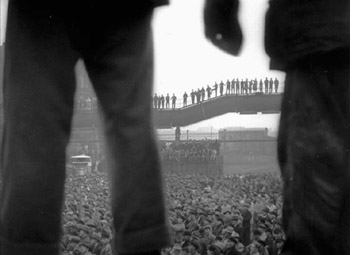 she might be just as dismissive of a classic John Ford film of the same era. It’s a good argument in favor of teaching students about the conventions of older films and helping them to watch them with more respect. Not knowing at least a little about the historical context could easily make younger generations not take the propaganda of the past any more seriously than they take the entertainment films of Hollywood in the 1930s and 1940s. (One can’t fault the granddaughter too much; she belongs to the family of anti-nuclear activists.)
she might be just as dismissive of a classic John Ford film of the same era. It’s a good argument in favor of teaching students about the conventions of older films and helping them to watch them with more respect. Not knowing at least a little about the historical context could easily make younger generations not take the propaganda of the past any more seriously than they take the entertainment films of Hollywood in the 1930s and 1940s. (One can’t fault the granddaughter too much; she belongs to the family of anti-nuclear activists.)
The filmmakers had extensive access to good prints of several of Harlan’s major films. One, Der Herrscher (“The Master,” 1937), deals with a factory whose owner is a strong leader type. The frame at left shows off Harlan’s feel for crowds that made him the equivalent for fiction film to Leni Riefenstahl as a documentarist. (Indeed, one might suspect a bit of influence here.) There are also home movies, some taken behind the scenes during the filming of Harlan’s Nazi-era films. Munich archivist Stefan Drössler adds some historical perspective. The exhibition shown in the film provides glimpses of key documents.
Harlan could be quite useful in the classroom. Obviously courses on German history would benefit from it. Film history classes could show it in a unit on Nazi cinema, either in combination with or as a replacement for Jud Süss or one of the other major Nazi film. But it also gives an interesting perspective on the post-war decades and the ways in which guilt and expiation could linger across generations.
Thanks to my friend Marianne Eaton-Krauss for recommending this film to me!
[Added October 31: Critic Kent Jones has kindly written to point out that Felix Moeller is Margarethe Von Trotta’s son. Kent has written a piece on Veit and Thomas Harlan in the May/June 2010 issue of Film Comment.]
The launch of a Russian DVD series
The Russian Cinema Council (RUSICICO) has recently released the first five DVDs in its new “Academia” series. The first group comes from the Soviet silent and early sound era: Strike, October, Happiness, The Great Consoler, and Engineer Prite’s Project. They can easily be ordered on the company’s website. Googling will find a few smaller online companies in Europe that sell them, but they are not available (yet, at least) from the larger sites like Amazon.
[January 31, 2012: Hyperkino has announced that its DVDs can now be purchased at a British site, MovieMail. For more on Hyperkino, see here.]
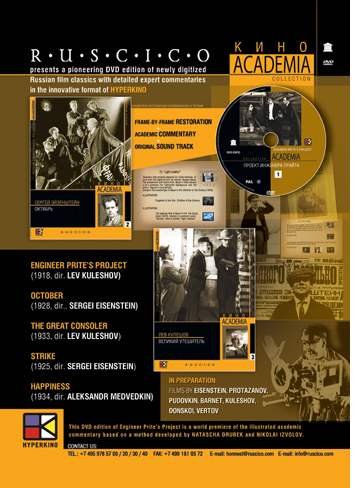 A major feature of these discs is “Hyperkino,” a version in which numbers appear at intervals in the upper right; clicking on them summons up an explanatory text. For Strike, for example, one can read an explanation of the “Collective of the 1st Works’ Theater” when that phrase appears in the credits. (The complete text of the annotations for Engineer Prite’s Project have been printed as an article in Studies in Russian and Soviet Cinema [Vol. 4, no. 1, 2010].) These “footnotes” would be of interest to film students, mainly at the graduate level; they would be invaluable for lecture preparation. The Hyperkino version appears on the first disc of each two-disc set; the film without the feature appears on the other disc. Despite the fact that the text on the boxes are almost entirely in Russian, the films have optional subtitles in English, French, Spanish, Italian, German, and Portuguese; the Hyperkino notes are available only in Russian or English. The discs have no region coding.
A major feature of these discs is “Hyperkino,” a version in which numbers appear at intervals in the upper right; clicking on them summons up an explanatory text. For Strike, for example, one can read an explanation of the “Collective of the 1st Works’ Theater” when that phrase appears in the credits. (The complete text of the annotations for Engineer Prite’s Project have been printed as an article in Studies in Russian and Soviet Cinema [Vol. 4, no. 1, 2010].) These “footnotes” would be of interest to film students, mainly at the graduate level; they would be invaluable for lecture preparation. The Hyperkino version appears on the first disc of each two-disc set; the film without the feature appears on the other disc. Despite the fact that the text on the boxes are almost entirely in Russian, the films have optional subtitles in English, French, Spanish, Italian, German, and Portuguese; the Hyperkino notes are available only in Russian or English. The discs have no region coding.
The prints of Strike and October are both the familiar step-printed versions. The visual quality is reasonably good.
(We did not purchase the Happiness disc, since the film had already been available in DVD and we’re not Medvedkin specialists.)
The most important contribution of the series so far has been to make two rare Kuleshov titles available to the general public for the first time. Engineer Prite’s Project was his first film. Previously it was available in archives in a print lacking intertitles. The story was so difficult to follow that the film seemed to be incomplete. Now, with the intertitles reconstructed and inserted into the film, it makes sense. It’s a short feature about industrial intrigue, notable in its mixture of traditional European tableau staging style and some sophisticated American-style editing that was a complete innovation for Russian cinema. The release of Engineer Prite’s Project on DVD fills a large gap in the history of the Soviet silent cinema, since it was the first film by one of the group that would form the Montage movement. Indeed, the fast cutting in a brief fight scene looks forward to that movement:
The DVD also includes a documentary, The Kuleshov Effect, made in 1969. It’s a helpful overview, with clips from the major films up to The Great Consoler, along with interviews with Kuleshov, scenarist and Russian Formalist critic Viktor Shklovski, and others. It’s just under an hour and would be a great teaching tool for a history or theory class.
If Engineer Prite’s Project is of interest mainly for its historical significance, The Great Consoler is perhaps Kuleshov’s masterpiece. The complex, multi-leveled narratives so popular in contemporary cinema have nothing on this film’s storytelling. It shifts among three levels with thematic parallels. In one, an abused, miserable shop girl (played by Alexandra Khokhlova, Kuleshov’s wife and leading proponent of the “biomechanical” school of acting) reads O. Henry short stories as escapism. In another, O. Henry himself is seen in prison (as he was in real life). In a third, we see a dramatization of his tale of convict Jimmy Valentine (“A Retrieved Reformation”). Each level is filmed in a slightly different style, and the moralistic lesson–those who suffer from exploitation under capitalism find only hollow consolation in popular culture–is somewhat undercut by the zestful stylization with which Kuleshov presents the sentimental tale of Valentine.
Chaplin (Slowly) Becomes The Little Tramp
On October 26, Flicker Alley is coming out with another of its big boxes of restored films. (Amazon has it available for pre-order.) This time it’s four discs containing a group of 34 of Charlie Chaplin’s Keystone-era films (of the 35 he made there). The press release describes the lengthy process of finding and restoring prints, which involved several archives:
With the support of Association Chaplin (Paris), 35mm full aperture, early-generation materials were gathered over an eight year search on almost all the films from archives and collectors 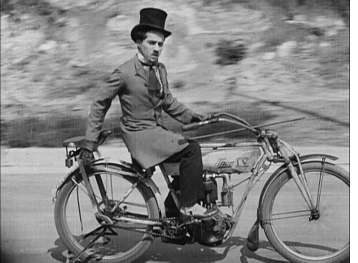 around the world, and were painstakingly piece together and restored by the British Film Institute National Archive, the Cineteca di Bologna and its laboratory L’Immagine Ritrovata in Italy, and Lobsters Films in Paris. Most are now clear, sharp and rock-steady, although some reveal that their source prints are well-used and a handful survive only in 16mm.
around the world, and were painstakingly piece together and restored by the British Film Institute National Archive, the Cineteca di Bologna and its laboratory L’Immagine Ritrovata in Italy, and Lobsters Films in Paris. Most are now clear, sharp and rock-steady, although some reveal that their source prints are well-used and a handful survive only in 16mm.
The earlier films in the set remind us that Chaplin began as a player in films where Mabel Normand was the star attraction (and she directed them herself). He didn’t always wear his “Little Tramp” outfit, either. Such films as The Property Man, The Rounders (co-starring Fatty Arbuckle), and Tillie’s Punctured Romance (restored by the UCLA archive) are included. A trim little booklet by Jeffrey Vance includes historical background and program notes. Original musical accompaniment is provided by Neil Brand, Robert Israel, and others. On-disc bonus materials include a documentary, “Inside the Keystone Project” and a couple of Chaplin-related silent films from the era, including a cartoon featuring him as a character.
Chaplin devised his “Little Tramp” outfit during this early era, though he didn’t use it in every Keystone film. He wasn’t yet the poignant figure of the later 1910s and 1920s. In Mabel at the Wheel, for example, he’s a pugnacious, bomb-wielding villain, with Mabel Normand, who directed the film, in the lead. (At left above, he belatedly 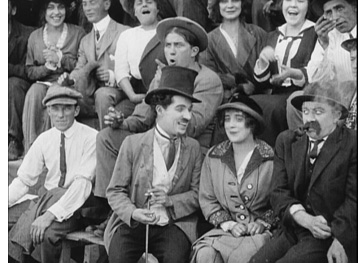 discovers that Mabel is no longer seated behind him on the motorcycle.) Chaplin buffs will have a field day with this set. The clarity makes it easier to spot the many comics who play bit roles here. Mack Swain wanders through, Mack Sennett has a small role as a yokel, and one can see a very young Edgar Kennedy seated behind Chaplin in the bleachers (right).
discovers that Mabel is no longer seated behind him on the motorcycle.) Chaplin buffs will have a field day with this set. The clarity makes it easier to spot the many comics who play bit roles here. Mack Swain wanders through, Mack Sennett has a small role as a yokel, and one can see a very young Edgar Kennedy seated behind Chaplin in the bleachers (right).
Each film is preceded by a title card that specifies the source material for the restoration, as well as the archives and other institutions involved. Mabel at the Wheel, for example, was assembled from four nitrate prints held by various collections. As the frames here indicate, it’s generally very clear and undamaged, though occasionally a shot from a more worn print appears.
We often complain about seeing films for the first time on DVD when they were meant to be seen on celluloid projected on the big screen. But for rare silent films like these Chaplin shorts, DVD replaces the old 8mm and 16mm prints that I remember from my graduate-school days in the 1970s. Our friend and colleague Frank Scheide, who was writing his dissertation on Chaplin’s music-hall background, would present programs of such prints in his home, but there were items that remained elusive. (Frank has co-edited two anthologies on Chaplin’s later films; see here and here.) Now we’re lucky enough to have archives restoring films in part to make available in the new format. Most of these images are far better quality than 8mm or even 16mm could render.
As with the giant Georges Méliès boxed set released in 2008, the new Chaplin discs make it easy to go through his career in strict chronological order, either as the films were made or as they were released (often not the same thing in those early days). The set is a vital item for collections of silent films and will no doubt feature among the nominees in the DVD awardsfor next year’s Bologna festival, Il Cinema Ritrovato. Three Hyperkino titles were among last year’s winners.
Mark your calendars!
On November 7, Turner Classic Movies will be showing the new restoration of Metropolis (8 pm Eastern time), followed by a one-hour documentary Metropolis Refound (11 pm Eastern time), on the discovery of a nearly complete print in An Argentinean archive. On November 4, the restored Pandora and the Flying Dutchman (1951; starts at 10 pm Eastern time) will be shown. It’s by the little-known auteur Albert Lewin; if you love Powell and Pressburger movies, you’ll probably love this film. Every Monday from November 1 to December 13, TCM will air its original series, Moguls & Movie Stars (8 pm Eastern time). Each episode will be followed by several films of the era discussed. One highlight not to be missed is Lois Weber’s wonderful 1921 feature, The Blot. It’s probably the only film ever made about the low pay of university professors, but its real strength is in the character study of haves and have-nots living next door to each other. Back when I taught a history of silent cinema class at the University of Iowa in 1980/81, this was one of the films I showed to demonstrate that silent films weren’t as simple and naive as young people today might assume. (The other was King Vidor’s 1924 Wine of Youth.) Set your recorders, since The Blot airs at 4:45 am EST on November 8. For more highlights, keep checking the TCM website, which hasn’t yet posted its November schedule.
Harlan: Im Shatten von Jud Süss
A last celluloid banquet from Vancouver
Detail from “Crimson Autumn” (1931) by Ural Tansykbaev (from The Desert of Forbidden Art)
Kristin here:
A Film Unfinished (Israel; dir. Yael Hersonski, 2010)
A Film Unfinished satisfies on many levels. It is based on several reels of an unfinished Nazi propaganda film labeled “The Ghetto,” discovered among an archive of thousands of cans of Nazi footage. On a simple documentary level, the scenes in the film show precious evidence of life in the Warsaw ghetto in the 1941-42 era, before most of its inhabitants were sent to death camps. As a piece of historical research on the part of the filmmakers, who found written and taped material that shed considerable light on this mysterious footage, it 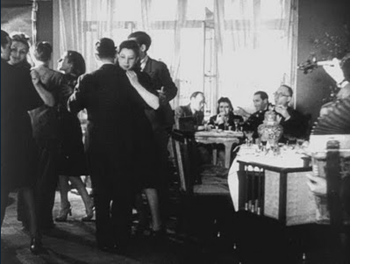 comes across as a tightly constructed detective story. For theorists of documentary who want to stress that no non-fiction films can reveal life as it is, without manipulation, A Film Unfinished provides a dramatic example.
comes across as a tightly constructed detective story. For theorists of documentary who want to stress that no non-fiction films can reveal life as it is, without manipulation, A Film Unfinished provides a dramatic example.
The samples from the silent footage shown early in A Film Unfinished show a strange combination of subject matter. Apparently candid footage of people in the street, going about their daily lives, is mixed in with scenes of well-dressed men and women in restaurants or elegant apartments. How do these incongruous scenes fit together?
The filmmakers found extensive diaries kept by one of the officials in charge of the Ghetto, as well as taped testimony given in 1961 by one of the main cameramen who recorded the footage. Passages from these, read over additional footage from the film,gradually reveal at least part of the purpose behind the footage. The Nazis apparently wanted to show that some inhabitants of the ghetto were living a normal, even luxurious life (above left). But other scenes were shot showing these same people on sidewalks. Beggars pass by them, but the actors playing the well-off Jews were instructed to ignore them. The result would 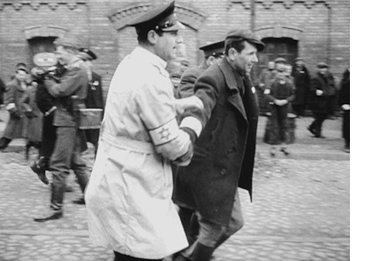 presumably have been a display of Jews not only living well but also indifferent to the fates of their less fortunate neighbors.
presumably have been a display of Jews not only living well but also indifferent to the fates of their less fortunate neighbors.
The filmmaking process frequently intrudes. Apart from the voiceover readings from witnesses to the filming, there are occasional glimpses of cameramen in the backgrounds of scenes (left). Moreover, one reel of the rediscovered film turned out to be unedited takes of several brief sequences, showing retakes of the same footage. Thus an apparently candid shot of two little boys looking into a shop window abundantly stocked with food turns out to have been staged; we even get a glimpse of one of the filmmakers leaning into the shot to direct the boys. A scene of police clearing a crowded street was done by assembling a large group of Jews and then having the police drive people away (the scene at left being part of that action). Urgency was added when the filmmakers fired shots into the air to frighten the crowd.
An added layer was given to A Film Unfinished by assembling a small group of men and women from the ghetto who witnessed many of the events. They are seen watching the film and adding comments. One remembers having seen the filming. Another worries that she will see someone she once knew among the faces on the screen. The presence of these witnesses emphasizes the fact that what we are watching in the rediscovered footage is both an elaborately staged series of events and a grim record of reality in the ghetto. A particularly grim sequence shows men with a handcart gathering corpses from the sidewalks (where helpless relatives, without any other recourse, dumped them overnight). These are taken to a mass grave, where they are stacked like firewood, covered with sheets of paper, and buried. Though the men working at this grisly task were clearly told what to do by the filmmakers, the fact remains that this gathering and disposing of bodies was a routine that went on daily in the late days of the ghetto.
A Film Unfinished would be very useful in a class on documentary cinema.
The Desert of Forbidden Art (Russian/USA/Uzbekistan; dir. Tchavdar Gorgiev and Amanda Pope, 2010)
Our interest in 1920s and 1930s Soviet avant-garde art led David and me to this film. It reveals the remarkable, unknown work of Igor Savitsky, a Russian Russian archaeologist who discovered the culture and art of the Karakalpakstan region of Uzbekistan. Applying for government funds to create the Karakalpak Museum of Arts, Savitsky initially stocked it with the jewelry, costumes, pottery, and other local cultural artifacts that were discouraged by the Soviet modernization policy.
He also discovered that there were many hidden paintings and drawings by artists whose avant-garde tendencies had gotten them into trouble with the central Soviet government in the Stalinist era. In 1966 he secretly–and very illegally–began using government money to buy up whole caches of these works. By the time of his death in 1984, he had acquired around 44,000 of them! Many are still in storage, awaiting restoration, but the galleries of this remote museum are full of extraordinary, hitherto unknown artworks.
The Desert of Forbidden Art is informative not only about the history of Savitsky and the museum, but it reveals something of the current culture of this isolated province, a culture which figures prominently in the artworks as well. Sons and daughters of the artists appear on camera, as does Marinika Babanarzorova, the museum’s current director. Naturally many beautiful artworks are on display as well.
The film touches only briefly on the fact that these artworks have been hidden away in a remote desert area which is also increasingly under the sway of Islamic extremism. A few documentary shots show the dynamiting of ancient rock-cut Buddha statues in adjacent Afghanistan in 2001. The head of the Nukus Museum was invited to appear with the film at the VIFF, but she was unable to get permission to leave the country. One is left wondering whether these artworks will need to be rescued anew.
The film is screening widely at film festivals and societies, mostly in the USA but in a few other countries as well. See its website for a schedule of upcoming showings. It also will be run in April or May, 2011 in the PBS series “Independent Lens.”
Certified Copy (France/Italy/Belgium; dir. Abbas Kiarostami, 2010)
This was the film I was most looking forward to at the festival, and it was the last–and best–one I saw. As usual, Kiarostami has come up with a novel approach to storytelling. (See David’s entry on Shirin.) After only one viewing, I’m not confident enough to say much about Certified Copy. Besides, almost anything I say about the plot will give away too much. This is a puzzle film that unfolds very slowly and very subtly.
It seems to work in ways almost opposite to those of the big puzzle film of the year, Inception. That film was almost all exposition, which we had to frantically note and try to piece together to get even a rough grasp of the plot. Certified Copy has almost no exposition–or none that we can recognize immediately or even trust when we do recognize it. I could gauge how slowly that recognition comes by the fact that the laughter at apparently incongruous behavior between the characters gradually faded. Different members of the audience realized at different moments that what had seemed incongruous maybe wasn’t after all, though it’s possible that the incongruity was just increasing right up to the end. Close to the end, only a lady two rows behind me was still laughing.
Essentially what happens is that a plot unfolds, and despite a lack of solid information, most of us probably infer from the conversations enough to assume we understand the two main characters and their relationship. Eventually their actions suggest that perhaps an entirely different plot and relationship has been unfolding all along. (This comes fairly late in the film, in maybe the last third or even quarter.) Perhaps the information we receive does not allow us to decide in this ambiguous situation, though I think people do tend to decide. I decided one way, David decided the other.
Interestingly, this mirrors in longer form the last sequence of Under the Olive Trees. There we are not told what the girl replies when the boy runs after her and proposes marriage one last time. In that case, too, I decided one way, David the other. Years ago we told Kiarostami this, and he laughed and said men tend to assume the girl accepts him, while women assume she rejected him. (I think there actually are some fairly clear clues earlier in the film that she will reject him, but explaining those would be a different entry.) That may be the case here, that men and women will reach opposite conclusions.
On the other hand, and this would require at least a second viewing, the film may remain utterly ambiguous about which plot is “real.” Or it may even stray into the territory of the inexplicable, à la Buñuel or David Lynch, where the difference parts of the story are each “true” but incompatible. M. Tsai suggests, “‘Certified Copy’ plays out a bit like a romantic comedy directed by David Lynch with its distinct two-halves connected by a thread.” (Not to be read until you’ve seen the film.)
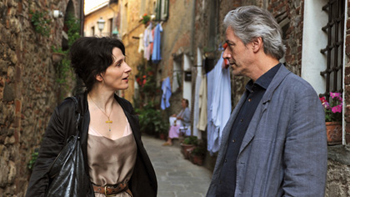 Apart from its teasing, baffling, shifting elements, Certified Copy contains two fine lead performances and, of course, some beautiful cinematography. There’s a bit of a surprise, in that Kiarostami for the most part avoids his characteristic sweeping views of landscapes. Tuscan hilltop towns would seem to be perfect for his typical shots of vehicles struggling up bending roads, but we are largely confined inside the car during the driving scene, watching the characters and not the glimpses of trees through the windows. Those yearning to see Italy must be content with stone or painted stucco walls (as at the left).
Apart from its teasing, baffling, shifting elements, Certified Copy contains two fine lead performances and, of course, some beautiful cinematography. There’s a bit of a surprise, in that Kiarostami for the most part avoids his characteristic sweeping views of landscapes. Tuscan hilltop towns would seem to be perfect for his typical shots of vehicles struggling up bending roads, but we are largely confined inside the car during the driving scene, watching the characters and not the glimpses of trees through the windows. Those yearning to see Italy must be content with stone or painted stucco walls (as at the left).
For many links to articles and reviews, see David Hudson’s helpful wrap-up on Mubi. (Again, not until you’ve seen the film.)
Sodankylä Forever (Finland; dir. Peter von Bagh, 2010)
DB here:
Do writers write books about fanatical readers? Do composers write operas about opera lovers? Sometimes, but not to the degree that cinephiles delight in making films about their passion. Case in point: Peter von Bagh’s Sodankylä Forever. The Festival screened two films devoted to Finland’s Midnight Film Festival, which not only runs movies around the clock but hosts marathon interviews with filmmakers.
It isn’t your usual red-carpet event. The town is tiny. Guests are treated to campfire cookouts and invited to play soccer. But watching old clips, catching snatches of the Johnny Guitar theme, and hearing revered directors spin their yarns is enough to bring pleasure. There are moments of drama—Zanussi and Makavejev boycott a screening of Potemkin because of its “totalitarian” ideology—but mostly the filmmakers muse in a relaxed fashion about the good, and bad, old days.
The Yearning for the First Cinema Experience treats a core cinephile topic: What was your earliest encounter with the movies? Disney films, as you might expect, play a major role, but so too does Frankenstein (which made Victor Erice realize that people kill other people) and even the MGM lion (which startled Kiarostami in his childhood). The First Experience includes more mature epiphanies, such as Bob Rafelson’s obsessive visits to Manhattan’s Thalia. If the official classics get particular attention, it’s perhaps because, as Costa-Gavras says, “Everything was done in the silent cinema.”
So cinephiles are nostalgists, sentimentalists, even narcissists. But we aren’t oblivious to history behind the screen. The Century of Cinema episode focuses on directors’ relation to World War II (a continuing fascination of von Bagh’s). An era of purges, battlefront savagery, and prison camps, created, Szabo reflects, “a generation without fathers.” Jancsó, who served time in a Finnish POW camp, pays tribute to his hosts with a recitation, in Hungarian, of the opening of the Kalevala.
After the war, however, several Western European directors recall the advent of a new era of intelligence and creative engagement. The spirit was most apparent in the Italian Neorealist films. Erice tells of sneaking a forbidden print of Rome, Open City out of customs so that Spanish cinephiles could see it. In Eastern Europe, of course, things were different, and tales of censorship and young directors’ struggle to innovate are treated as continuations of wartime crises and constraints. Alexei German sums up the status of the artist who refuses to affirm official culture: “We are not the doctors, we are the pain.” Samuel Fuller, who has already explained that being assigned to a rear-guard unit in a retreat is a death warrant, is given the epilogue. He recalls visiting the tidiest graveyard he has ever seen and turning to watch the wind rustling the grass. Was he imagining how the scene would look on film? Naturally, arch-cinephile von Bagh shows us.
DB, Abbas Kiarostami, KT. Chicago, March 1998.
DER GOLEM: Revisiting a classic
Kristin here:
In 2009, Il Giornate del Cinema Muto, the silent-film festival held each year in Pordenone, Italy, launched a new series. “Il canone rivisitato/The Canon Revisited” addressed the fact that many rare and often obscure silent films are made available through restoration each year, and yet many young enthusiasts who have started attending the festival have seldom had the chance to see the classics on the big screen with musical accompaniment. The opening group of films proved highly successful, and “Il canone rivisitato 2” will be presented this year, when Il Giornate will run October 2 to 9.
Part of the point of the series is to have historians re-evaluate these classics and examine how well they live up to their status as part of the film canon. Last year I contributed a program note on Paul Wegener and Karl Boese’s 1920 German Expressionist film Der Golem. This year I’ve written about Danish director Benjamin Christensen’s 1916 thriller Hævnens Nat (Night of Revenge, released in the U.S. in 1917 as Blind Justice), which will be shown this year, and rightly so.
When I went back and reread my Golem notes to remind myself what sort of coverage is needed, I decided that the text I wrote then might be of wider interest to those who weren’t at the festival last year. Thanks to Paolo Cherchi Usai, one of the festival’s founders and organizers, for permission to revise my brief essay as a blog entry. I’ve changed it minimally and taken the opportunity to add illustrations. Here’s what I said at the time:
Der Golem is a classic film—doubly so.
First, it has long nestled comfortably within the list of titles that make up the German Expressionist movement of the 1920s. Teachers of survey history courses are more likely to show Das Cabinet des Dr. Caligari (which premiered in early 1920) but a serious enthusiast will make it a point to see Der Golem (which appeared later the same year) as well.
From the start, reviewers recognized Der Golem as Expressionist. In 1921 the New York Times’ critic wrote, “Resembling somewhat the curious constructions of THE CABINET OF DR. CALIGARI, the settings may be called expressionistic, but to the common man they are best described as expressive, for it is their eloquence that characterizes them” (George Pratt’s Spellbound in Darkness, p. 362). In 1930, Paul Rotha’s The Film Till Now, the most ambitious world history of cinema in English to date, appeared. Highly influential in establishing the canon of classics, Rotha adored Weimar cinema, including Der Golem.
In 1936, the Museum of Modern Art obtained a large number of notable European films. The core collection of the young archive contained such prestigious titles as Caligari, Battleship Potemkin, Metropolis, and Der Golem. These films soon became part of the museum’s 35mm and 16mm circulating programs. With MOMA’s sanction as historically important classics, they remained the most widely accessible older films available to researchers and students alike for many decades.
There is, however, a second, largely separate audience: monster-movie fans. Starting in the 1950s, German Expressionist films were promoted as horror fare by Forrest J. Ackerman in his magazine Famous Monsters of Filmland. In 1967 Carlos Clarens included Der Golem in his An Illustrated History of the Horror Film. Really dedicated horror devotees pride themselves on their expertise across a wide variety of films, including foreign and silent ones. Der Golem became a certified horror classic.
In the 1950s and 1960s, companies offering public-domain 8mm and 16mm copies for sale enabled both film-studies departments and movie buffs to start their own film libraries. Ultimately home video made previously rare silent classics easily obtainable—including a restored Golem from the Friedrich Wilhelm Murnau-Stiftung, with new tinting and a musical score, on DVD. Such a presentation reconfirms the film’s status as a classic.
But what sort of classic is it? An undying masterpiece that one must see immediately? A film one should definitely watch someday if the chance arises? On the occasion of Der Golem being presented on the big screen with live musical accompaniment, we have a chance to specify what distinguishes it from its fellow exemplars of Expressionism.
I suspect that horror-film fans won’t feel that a reevaluation is necessary. Der Golem is a forerunner of Frankenstein and hence an important early contribution to the genre. It’s a striking film to look at and obscure enough to impress one’s friends during a late-night program in the home theater.
But for film historians returning to Der Golem in the early twenty-first century, after nearly ninety years of taking it for granted, what is there to say?
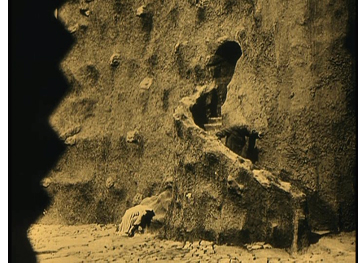 Some would deny that Der Golem is truly Expressionistic. If one has a very narrow view of the style, insisting that only films with flat, jagged, Caligari-style sets qualify for membership in the movement, then Der Golem doesn’t pass muster. Neither do Nosferatu, Die Nibelungen, Waxworks, and a lot of other films typically put into the Expressionist category.
Some would deny that Der Golem is truly Expressionistic. If one has a very narrow view of the style, insisting that only films with flat, jagged, Caligari-style sets qualify for membership in the movement, then Der Golem doesn’t pass muster. Neither do Nosferatu, Die Nibelungen, Waxworks, and a lot of other films typically put into the Expressionist category.
It’s a subject susceptible to endless debate. To avoid that, it’s helpful to accept historian Jean Mitry’s simple, useful distinction between graphic expressionism, with flat, jagged sets, and plastic expressionism, with a more volumetric, architectural stylization. If Caligari introduced us to graphic Expressionism in 1920, Der Golem did the same for plastic Expressionism later that year.
For me, seeing Der Golem again doesn’t much affect its status as an historically important component of the German Expressionist movement. It’s not the most likeable or entertaining of the group. Caligari has more suspense and daring and black humor. Die Nibelungen has a stately blend of ornamental richness with a modernist austerity of overall composition, as well as a narrative that sinks gradually into nihilism in a peculiarly Weimarian way.
Moreover, Der Golem’s narrative has its problems. None of the characters is particularly sympathetic. Petty deceits and jealousies ultimately are what allow the Golem to run amok. The narrative momentum built up in the first half of  the film is inexplicably vitiated for a stretch. Initially the emperor’s threat to expel Prague’s Jews from the ghetto drives Rabbi Löw to his dangerous scheme of creating the Golem to save his people. Yet after the creation scene, the dramatic highpoint that ends the first half, we see the magically animated statue chopping wood and performing other household tasks that make his presence seem almost inconsequential. The imperial threat has to be revved up again to get the Golem-as-savior plot going again.
the film is inexplicably vitiated for a stretch. Initially the emperor’s threat to expel Prague’s Jews from the ghetto drives Rabbi Löw to his dangerous scheme of creating the Golem to save his people. Yet after the creation scene, the dramatic highpoint that ends the first half, we see the magically animated statue chopping wood and performing other household tasks that make his presence seem almost inconsequential. The imperial threat has to be revved up again to get the Golem-as-savior plot going again.
But putting aside Der Golem’s minor weaknesses, it has marvelous moments that summon up what cinematic Expressionism could be: the opening shot, which instantly signals the film’s style (below); the black, jagged hinges that meander crazily across the door of the room where Löw sculpts the Golem; the juxtaposition of the Golem with a Christian statue as he stomps across the crooked little bridge returning from the palace (at top).
Hans Poelzig was perhaps the greatest architect to design Expressionist film sets. He designed only three films, and Der 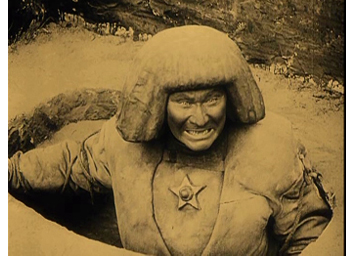 Golem is the most important of them. Once the monster has been created, Poelzig visually equates the lumpy, writhing towers and walls of the ghetto and the clay from which the Golem is fashioned. The sense that sets and actors’ performances constitute a formal, even material whole became one of the basic tactics of Expressionism in cinema.
Golem is the most important of them. Once the monster has been created, Poelzig visually equates the lumpy, writhing towers and walls of the ghetto and the clay from which the Golem is fashioned. The sense that sets and actors’ performances constitute a formal, even material whole became one of the basic tactics of Expressionism in cinema.
Speaking of performances: A lot of the actors in German Expressionist films were movie or stage stars who didn’t specialize in Expressionism. There were, however, occasional roles that preserve the techniques the great actors of the Expressionist theater. There’s Fritz Kortner in Hintertreppe and Schatten. There’s Ernst Deutsch, who acted in only two Expressionist films, as the protagonist in the stylistically radical Von morgens bis Mitternacht (out this month on DVD) and as the rabbi’s assistant in Der Golem.
Just watching his eyes and brows during his scenes in this film conveys something of the experimental edge that Expressionism had when it was fresh—before its films had become canonized classics.
Scorsese, ‘pressionist
Shutter Island.
I was interested in the way she presented herself at that moment. Later on I figured out that as she gets up from the chair we should do it in three cuts, three separate close-ups, because I think he’ll never forget that moment the rest of his life. He’ll play it back many times. . . . It’s just his perception, his memory of what it’s going to be like. . . . We shot it very quickly, two takes each, one at 24 frames, one at 36, and one 48.
Martin Scorsese, on filming The Age of Innocence.
DB here:
Few directors think so carefully about how a film looks and sounds. Sensitive to technique in the work of classic filmmakers, Martin Scorsese has always tried to give each picture a vivid visual and auditory profile. Although he’s often praised for his realism (usually prefaced by the adjective “gritty”), Scorsese is often a subjectively oriented director. This quality goes beyond the justly celebrated performances of his actors. He is unafraid to use unusual cinematic techniques to thrust us boldly into the characters’ minds and emotions. In this effort he joins some great cinematic traditions. No surprise there: He has an immediate sense that film history hovers over every choice a director makes.
Spoilers loom out of the mist ahead.
Inside out, outside in
Raskolnikov.
Once American filmmakers developed a model of visual storytelling in the late 1910s, filmmakers elsewhere were surprisingly quick to push it in more subjective directions. There emerged something like an international division of techniques.
To convey inner experience, German directors of the 1910s and 1920s worked principally on aspects of mise-en-scene—performance, staging, setting, lighting, costume, make-up, and the like. The classic example is The Cabinet of Dr. Caligari (1920), in which the cutting and camerawork are fairly conservative, but the setting and acting seek to convey a madman’s vision of the world.
Caligari “subjectivizes” the characters’ surroundings, a process signaled through warped perspectives and fantastically distorted settings.
This brand of visual contortion became the hallmark of what was called German Expressionist cinema. Scholars argue about exactly what films belong under that rubric, but Caligari, along with From Morn to Midnight (1920) and Raskolnikov (1923, above), are pretty uncontroversial examples of making the external world reflect the characters’ psychic turmoil.
At the same period, French directors were also experimenting with subjective cinema. But they tended to concentrate less on mise-en-scene and more on what the camera could do to suggest both optical and mental point of view. In the so-called “French Impressionist” school, we find framings, angles, distorting lenses, changes of focus, slow-motion, and other cinematographic techniques used to suggest characters’ mental states. Thus in Germaine Dulac’s Smiling Madam Beudet (1923), the downtrodden wife sees her husband as monstrous.
In El Dorado (1921) Marcel L’Herbier uses a gauzy filter to suggest that his heroine is distracted, before pulling it aside and letting her face come into focus.
A little later, leading Soviet filmmakers made editing, not mise-en-scene or camerawork, their most salient technique. They experimented with graphic and rhythmic montage, as well as cuts that sacrificed spatial and temporal continuity to eye-smiting impact.
Of course this three-way division of technical labor is too neat. You find some camera experimentation in German Expressionism, as with the fast motion in Nosferatu (1922). The French were using rapid cutting even before the Soviets, as Gance’s La Roue (1923) shows. And some Soviets, such as Eisenstein and the FEKS directors, explored unusual lighting and camera angles. It should be said, though, that these shared techniques often serve different purposes. Fast cutting in Impressionist films tends to suggest the heightened experience of the characters, rather than serving, as in the Soviet case, to dynamize a historical situation for the viewer. The quick cutting in the carnival ride in Jean Epstein’s Coeur fidèle (1923) simulates the chaotic burst of “impressions” felt by the characters, but the quick cutting in the street riot of Strike (1925) doesn’t mimic the characters’ states but aims to arouse shock and suspense in us.
In any case, my technical division remains only a first approximation toward understanding pretty complicated historical trends. The main point is that both the German Expressionist and the French Impressionist filmmakers of the 1920s were seeking to use particular film techniques to give the audience a deeper sense of the characters’ sensory experience and emotional states.
American cinema selectively adopted some of these tactics of lighting and set design. In a blog entry and a web essay, I’ve written about William Cameron Menzies as one importer of the German approach. You can see Expressionist touches in Fox’s Mr. Moto movies. Likewise, 1940s films particularly enjoyed mimicking Impressionist camera tricks to signal drunkenness, delirium, hallucination, and other altered states. Hitchcock’s Spellbound (1945) and Wilder’s Lost Weekend (1945) are famous examples. Typically such Expressionist and Impressionist touches were associated with crime, craziness, or genre stylization. Much of this flagrant irrealism went out of A-pictures in the 1950s, but it survived in horror and, interestingly, in the US avant-garde cinema of Deren, Markopoulos, and others.
One of Scorsese’s contributions to the 1970s, I think, was to revive and consolidate this legacy. While we were celebrating his films as victories for urban realism and neo-Method acting, many of the movies were also charged exercises in subjective cinema.
Making streets mean, and meaningful
Taxi Driver.
From Mean Streets (1973) everyone remembers the aura of street-punk camaraderie, the harsh turns of mood (usually triggered by Johnny Boy’s recklessness), and the vibrancy of the neighborhood, with its social hierarchy and rituals of bullying and bluff and negotiation. Alongside these tokens of realism we find breathless grace notes, as when Charlie glides through the club, a visual equivalent of his joy in being among pals and sexy women. (The shot was made by having Keitel ride the dolly instead of walking in front of it.)
This euphoria of this neo-Impressionist shot is counterbalanced later by the Rubber Biscuit song, with Charlie now thoroughly drunk and floating in grotesque frontal close-up before the floor rises up to kiss his head.
Charlie has come in to the club announcing himself as Jesus, a pious man to create order. Now this shot charts his fall from drunken exuberance into queasiness and mounting anxiety about Johnny Boy’s debt.
More generally, Tony’s club is given heavily unrealistic treatment through slow-motion and faked slow-motion, along with character movement synchronized with the music. If the camerawork mimics Charlie’s mental states in Impressionist fashion, the ruby-red club lighting suggests his erotic inflammation in a mildly Expressionist one.
Taxi Driver (1976) is Scorsese’s most famous venture into subjectivity. From the first shot of the cab heaving through wafting vapor—steam? smoke? sulfur fumes?—we cut to a man’s eyes, and then to dissolving views of the city through a rainy windshield.
From the start Scorsese announces one of his most basic strategies: a realistic motivation for expressionist effects. It’s only rain, but shooting it through the windshield and adding slow motion gives the streets an otherworldly shimmer. As the neon dribbles down the glass, and we see pedestrians moving through tinted clouds like hesitant ghosts, the man’s face becomes bathed in a red glow—vaguely motivated as reflected from the traffic light, but unrealistically saturated, as in the Mean Streets club.
We see the real New York, but filtered through the eyes of a man who considers it an open sewer. The plot will soon lock us into his consciousness more explicitly, through restricted point of view and voice-over diary extracts and crisp montages of the cruising cab. In addition, the motifs introduced here, particularly purifying water and blips of light, will become elaborated in the course of the movie. The general point, however, is that Scorsese has updated Impressionist and Expressionist tactics in order to reveal a man’s mind through images.
Qui tollis peccata mundi
Bringing Out the Dead.
In some films Scorsese plays things straighter, invoking subjectivity only briefly. There are the prizefights and the visions of Vicki in Raging Bull (1980), and the slipperier passages of fantasy in The King of Comedy (1982). But other films plunge us deeply into subjectivity, forcing the world through the filter of a driven character’s sensibility.
For thoroughgoing efforts in this direction we can look to Bringing Out the Dead (1999). In this movie about a paramedic haunted by spirits of those unfortunates he might have saved, Scorsese along with cinematographer Robert Richardson and production designer Dante Ferretti reinvoke the nightmarish qualities of Taxi Driver. The exhilaration Frank Pierce gets from saving lives is offset by his despair at gambling with death every night. The result is another exercise in neo-Impressionism and –Expressionism.
Once again rain and light, objectively out there in the urban world, become projections of the character’s tormented psyche, thanks to camera angle and framing. The windshield gives Frank’s face phantom tears.
Once again concrete shapes and colors, filtered through a moving vehicle, are distorted to suggest the protagonist’s anxieties.
To measure Frank’s descent into desperation, the camera even follows the ambulance upside down, or sideways.
Scorsese ventures into full-blown Expressionism as well. There are naturally dream sequences, but we also get the unforgettable image of the drug dealer Sy, impaled on a fence rail and reaching toward skyscrapers as fireworks (real fireworks?) consecrate his gesture. Later, hurtling through the city and moving closer to mental breakdown, Frank starts to see every woman on the street as Rosa, the woman he could not rescue. How the Germans would have loved having CGI available for such a hallucination.
Perhaps the subtlest touches are the patches of blown-out white. At first they seem a signal of death, gleaming off the bodies of Mary’s father and the young man found on the street.
In the final scene, Frank tells Mary of her father’s death (and sees her as Rosa). She invites him in and eventually he falls asleep in her arms. The final shot quietly shifts from a normal, rather dark texture, to one endowing his shirt with a blinding glow.
This change in lighting and exposure, unmotivated by any realistic source, suggests that Frank feels he has found a bit of peace, while also hinting that a spiritual radiance has entered this unhappy world through a tortured secular saint.
Shutter Island caters to the ‘pressionist side of Scorsese’s vision. It hovers between realism and subjectivity: parts of what we see are really happening in the fiction, while other parts are wholly in Teddy/ Edward’s mind. The difference is that here the balance tips strongly toward expressionism. Apart from the dream sequences, certain hallucinations are rendered in undistorted terms. So, for instance, scenes like the cave conversation with the second Rachel Solando are wholly Teddy’s mental projections. Other scenes oscillate between subjectivity and objectivity, as when Teddy is preparing to set fire to Cawley’s car and talks with his wife Dolores–although the next shot confirms she’s not really there.
I find all this less resourceful than the virtuosic ways in which Scorsese subjectivizes the neighborhoods of New York. The Gothic trappings of the hospital, the cagelike wards, and the rainswept island offer less opportunity for novel stylization than an urban landscape. Moreover, I think that the creaky gimmick ruling the plot of Shutter Island relies on farfetched explanations and leaves too many loose ends. If the storm didn’t really occur, as Dr. Cawley tells us, then did the storm-tossed dialogues with Chuck not occur either? Why are the doctors talking about the prospects of a (nonexistent) flood before Teddy even comes into the room? And could the inmates be relied upon to execute the physicians’ complex role-playing game? A second viewing left me in the dark about matters that a Shyamalan would have tidied up.
But I did have to admire the way in which Scorsese uses Teddy’s breakdown as an alibi for the mismatched cuts I’ve objected to before. (Some legerdemain with a water glass is particularly clever.) And the ending supplies one further twist that somewhat ennobles the whole loopy contraption.
Cranking it up
Crank 2: High Voltage.
You can argue that Scorsese’s talent was well suited to this project: We don’t notice the plot problems because his stylistic assurance carries us along smoothly. That assurance allows me to raise my final point.
I’ve argued elsewhere, in books and on this site, that Hollywood storytelling techniques have been overhauled in recent decades. Over the last forty years or so, filmmakers have amped up the “continuity style” forged in the 1910s. They have cut faster, sometimes averaging 2-3 seconds per shot across a film. They have relied more heavily on singles (shots of one character), and these singles are often fairly large close-ups. Directors have also embraced extremes in lens lengths—very long lenses (for that perspective-flattening effect) and very wide-angle ones (often yielding flagrant distortions). Filmmakers have also relied a great deal on camera movement, frequently tracking in or out or even circling around the characters as they speak. The basic premises of continuity cinema aren’t violated, but the result is more aggressive visuals. Hence my label “intensified continuity.”
I think that intensified continuity became the new baseline for popular filmmaking both in the US and overseas. Over this style, however, some filmmakers have laid lots of fancy filigree. Many flashy techniques fill our movies. We get slow-motion, fast-motion, reverse-motion, ramping, and freeze-frames. There are brutal jump cuts, ragged shifts between color and monochrome, deliberately awkward framings, abrupt overhead compositions, slippery focus, and jerky handheld shooting. On the soundtrack we get ominous rumblings, metallic crashes, and noisy transitions. The Bourne films and The Hurt Locker (2009) offer moderate examples, but edging toward the extreme you have Crank 2: High Voltage (2009). Here intensified continuity has itself been intensified to a height of frenzied artifice. “Over the top” doesn’t capture it. There is, it seems, no longer a top to go over.
This swaggering style takes classical space and time as its basis—we still have analytical cutting, over-the-shoulder shots, and the like—but it pushes beyond the modest demands of simply laying out dramatic elements for easy comprehension. The intensified approach, itself trying for punch, has been raised to a new level of shock and awe. This trend, I’d speculate, is an escalation of tendencies seen in 1970s-1980s filmmakers like Brian De Palma, Ken Russell, Nicholas Roeg, Ridley Scott, and Scorsese.
Scorsese’s stylistic élan proved enormously influential, I think; Mean Streets is virtually a compendium of the new techniques. But unlike some others, he explored the emerging style in order to probe characters’ feelings and moods. Many of today’s amped-up techniques come off as merely eye candy, or prods for visual arousal, or pieces of narrational subterfuge (as often in De Palma). Scorsese has sought to make these decorative techniques more operatic—perhaps in the tradition of Visconti, Michael Powell, and other filmmakers he admires. The images (and of course the music) swirl around the action, providing cadenzas that bring out feelings which his men often can’t articulate. Sometimes the stylistic accompaniment becomes bombastic, as I think Shutter Island largely is. Yet the finest of Scorsese’s pictures contribute to a rich tradition in which the cinema, normally committed to objective realism, makes palpable what goes on inside us.
Scorsese’s remarks on The Age of Innocence come from a Film Comment interview with Gavin Smith reprinted in Martin Scorsese Interviews, ed. Peter Brunette (Jackson: University Press of Mississippi, 1999), 200. For more on Expressionist and Impressionist silent cinema, see our Film History: An Introduction, Chapters 4 and 5. By the end of the 1920s, these tendencies and Soviet Montage were blending into a sort of international style, a development considered in Chapter 8.
Taxi Driver.
PS 24 April: Filmmaker Max Jacoby writes:
I just read your blog entry on Scorsese’s style. You point out the glowing light which appears in some scenes of Bringing out the Dead. That is actually a signature lighting effect of cinematographer Bob Richardson. He has used this before he came into contact with Scorsese. You can already see it in some of the Oliver Stone films that he shot, such as JFK. This glowing effect is achieved by combining an overexposed toplight (several stops over key) with a diffusion filter (such as a White Pro Mist) in front of the lens or a net behind the lens. You can actually see the pattern of the net in question on the close-up of Nic Cage that you picked; it clearly stands out from the out-of-focus highlights in the background.
The net is more than likely a Christian Dior Denier 10 stocking, made of silk. They are very sought after and hard to find nowadays, because Dior stopped making these some years ago and switched to nylon instead. Once that became known, you had plenty of cinematographers invading women’s underwear stores to buy up the last remaining stock!
Max’s point helpfully indicates how a director can give a DP’s preferred choice a particular function. It seems to me that Scorsese’s patterned usage of the glowing white patches creates a significant motif in the movie–especially when it dominates the last shot, always a crucial moment. Thanks to Max for this, and for a followup reference to Eric Rudolph’s article, “Urban Gothic” in American Cinematographer 80, 11 (November 1999), 30-41; available here. In it Richardson discusses the flaring whites I mention in the blog entry.












